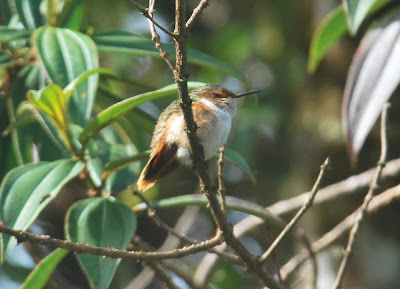Besides the endemic species and subspecies found in our last trip to the mountains of the Tabasará range, we also saw more widespread species of birds as you can imagine (read this entry for example). The group of intrepid birders consisted of William Adsett, Dan Wade and Charles Davies... and for us, every species was special in its special way. For example, check out this Spangle-cheeked Tanager... beautiful no matter how common it is!
We crossed several flocks, always three to six birds, most of the time mixed with other tanagers, finches and/or warblers. One of those times, the mixed flock was accompanied by a female Black-and-Yellow Silky-Flycatcher. This is an odd silky... it looks more like a colorful thrush, and some even think that this species doesn't belong to the family.
One important element in the Tabasará avifauna are the hummingbirds (as you may know by now). Besides confusing female Selasphorus, we saw more common species. In fact, the most common hummer all over the place was the Purple-throated Mountain-Gem. The ground epiphytes along the road through the slopes of Cerro Santiago were frequently visited by these hummers, allowing nice shots (here, adult and immature males, adult female).
Others hummers for the area included Green Violetear, Violet Sabrewing, White-tailed Emerald, Stripe-tailed Hummingbird, Green-fronted Lancebill and Green-crowned Brilliant. The male brilliant pictured here is quite blurry... but trust me that it was a real jewel glowing inside a beautiful cloud forest along the Continental Divide trail (above 1700 meters above sea level).
Not only the birds were putting a show, we saw some mammals, like this Pygmy-Squirrel in one of those productive forest patches along the road to the Ngöbe town of Ratón. We still need some help to ID this little friend.
And the critters were awesome too... Dan was our expert in this field, and we learned a lot. I will end this post with the photo of one of the coolest critter that I have seen. Enjoy!




































+male.JPG)
.jpg)
+male.JPG)

.JPG)

.jpg)










